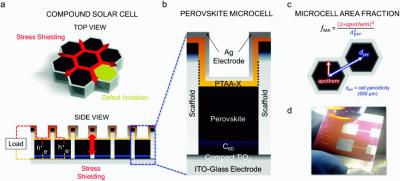Stanford University researchers have drawn inspiration from flies' eyes to tackle perovskite materials' stability (namely mechanical stability) challenges. The team created honeycomb shielded perovskite cells that got nearly the same power-conversion efficiencies compared to a standard photovoltaic cell, and held onto relatively high rates of efficiency after stress testing with extreme temperature (185F) and relative humidity over a six-week period.

The team set out to test the concept of a reinforced scaffold to solve the mechanical instability of perovskites. Using photolithographic methods, they were able to construct a hexagonal scaffold just 500 microns wide out of a durable polymer. Within this, they built the perovskite cells.
'What we've found is that not only is it mechanically much more durable, but it's also chemically more stable because, as I mentioned earlier on, if you heat up perovskite materials there are certain components in the perovskite that become volatile,' says the team. 'By essentially containing each individual cell, we could help slow down the loss of this volatile component of the material.'
Although this represents a milestone for perovskites' viability as a solar cell material, there are still challenges to overcome if they are to compete with existing photovoltaic cells. 'We've taken this basic proof of concept and we're now taking them further and developing more efficient scaffold cells,' say the researchers. 'We're learning to deal with the illumination and making sure that we don't lose any light in the scaffold walls themselves because obviously they take up space, and in taking up space they would absorb some of the light that actually shines onto the solar cell.'
To fight the potential loss of light that comes with using scaffolds, the team is looking at ways to use the structure itself to help scatter light into the cells. As they continue to develop the stability of perovskites, it appears that the compounds may be a significant step closer to reaching their solar potential.